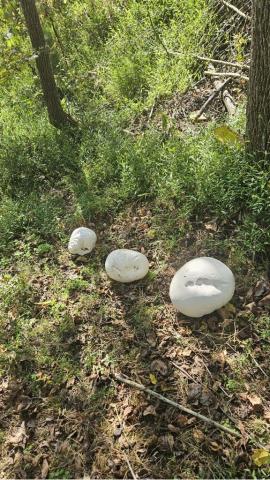Puffball Mushrooms and their fascinating history

Three large puffball mushrooms look strange, but are completely normal and expected after rainy weather. Photo by Jerry Walker, Sharps Chapel
Have you noticed little mushrooms popping up in yards this week? They seem to be everywhere lately! The rainfall from Hurricane Helene has certainly created ideal conditions here in Union County. This week, Union County Agriculture Extension Agent Shannon DeWitt identified a mushroom with a fascinating history: the Puffball mushroom. These large, white mushrooms, about the size of a basketball, were growing just along a tree line, characteristically in dead leaves.
Puffball mushrooms, though commonly found in lawns, are generally harmless to people, pets, and plants. These fungi are the fruiting bodies of a soil fungus that feeds on decaying organic matter, such as old roots and thatch. They tend to appear particularly after wet weather, as they thrive on moisture and organic decomposition in the soil.
Puffball mushrooms have been captivating for thousands of years. In fact, Puffballs were well-known among all the Native American tribes of North America, though their uses varied. Some tribes avoided them altogether, while the Cherokee used them to help heal sores and burns (early settlers in the blacksmith trade adopted this remedy too). Some people even wore dried puffballs around their necks to ward off ghosts and evil spirits.
The Blackfoot tribe, which historically spanned much of the Midwestern prairies of the U.S., often found puffballs growing in rings (what some people today call “fairy circles”). According to their legend, these puffballs were stars that had fallen to the Earth during a supernatural event. They also used dried puffballs as reliable tinder to start fires. To ensure a hearty fire in a tipi, they would sometimes paint representations of puffballs on the exterior canvas.
There are also accounts of Native American children joyfully stomping on mature puffballs, pretending that the resulting “smoke” was an eruption from a miniature volcano. Some things never change! That "smoke" is actually a cloud of countless spores. Giant puffballs can produce several trillion spores, but these spores have incredibly specific germination requirements. More than 99.99% of the time, conditions aren't right, so they don’t produce another mushroom. Perhaps just one spore out of trillions will grow into a new puffball. This is fortunate because if a single puffball had a 100% germination success rate, followed by the same for its offspring, the Earth would soon be overwhelmed. The resulting mass of fungi would amount to 800 times the volume of our planet!
Around 50 puffball species come from the Lycoperdon genus, which in Greek translates to "wolf fart mushroom"—"Lyco" meaning wolf and "perdon" meaning "to break wind." The origin of the "breaking wind" part is obvious, and if that doesn’t make you smile, who knows what will!
If puffballs in your lawn are an aesthetic concern, there are a few ways to manage them. You can simply dig them up or rake them away as they appear. Aerating your lawn can also improve drainage, as overwatering and poor drainage can encourage their growth. Additionally, maintaining good lawn hygiene by removing fallen leaves and branches can help limit the conditions that allow puffballs to thrive.
While puffballs don’t cause significant damage to your lawn, it’s wise to be cautious around children and pets, as some wild mushrooms can be poisonous. If you’re uncertain about any mushrooms in your yard, it’s best to leave them alone.
- Log in to post comments